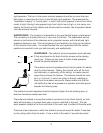
are connected identically. Unscrew the binding post, insert the wire into the hole, and
retighten. If you are using banana plug type wire connectors, insert them directly into
the posts making sure the lug on the negative (-) side of the banana plug is placed into
the black binding post. For each channel, connect the red terminal on the loudspeak-
er to the red or (+) loudspeaker connection terminal on the amplifier and the black to
the black or (-). Connecting the loudspeakers this way ensures that they will be in
phase; that is, work together, not in opposition. Connecting the loudspeakers out of
phase will not damage them, but will result in less bass and poor imaging.
6. If you have purchased the Synthesis Three Home Media System, which utilizes the
S3M speakers for the left and right channels, it is necessary to connect the five pin din
cable (included) to each speaker. This cable is essential to the system, for it allows the
speakers to switch from the music mode to the cinema mode. Plug one end into the five
pin din jack (located above the speaker terminals) and the other end into the jack locat-
ed on the power sequencer labeled “Speaker 1”. Do the same for the second speaker.
FINE TUNING YOUR AUDIO SYSTEM
ACOUSTICAL PROBLEMS IN LISTENING ROOMS
The Home THX Audio System addresses many of the problems common to high quality
reproduction of music or soundtracks in a home environment. For example, the dispersion
pattern of the front LCR speakers minimizes the effects of floor and ceiling reflections. Still,
there are many variables which are beyond the control of a manufacturer. Room reflections
create spurious false images and “comb filter” interference effects which alter the tonality of
the system while degrading the localization of specific sounds. Larger rooms sustain echoes
which degrade dialog intelligibility and detail. All rooms have standing waves which empha-
size certain frequencies at the expense of others, based on the dimensions of the room.
Other concerns include environmental noise, which is often greater than people real-
ize. Although they might become accustomed to its presence and “tune it out,” it still
reduces the perceived low-level resolution of the system. In addition, the profound
bass capabilities of a Home THX Audio System can create distracting rattles which
lesser systems might never evoke.
It can be tempting to try to solve all of these problems with the indiscriminate use of
sound-absorbing products, but even this technique has its pitfalls.
All of these common acoustical problems will be addressed in this section. Once
again, these techniques are not necessary for a successful Home THX Audio System
installation. Rather, they are provided to solve occasional problems and to provide fur-
ther enhancement possibilities.
8


















